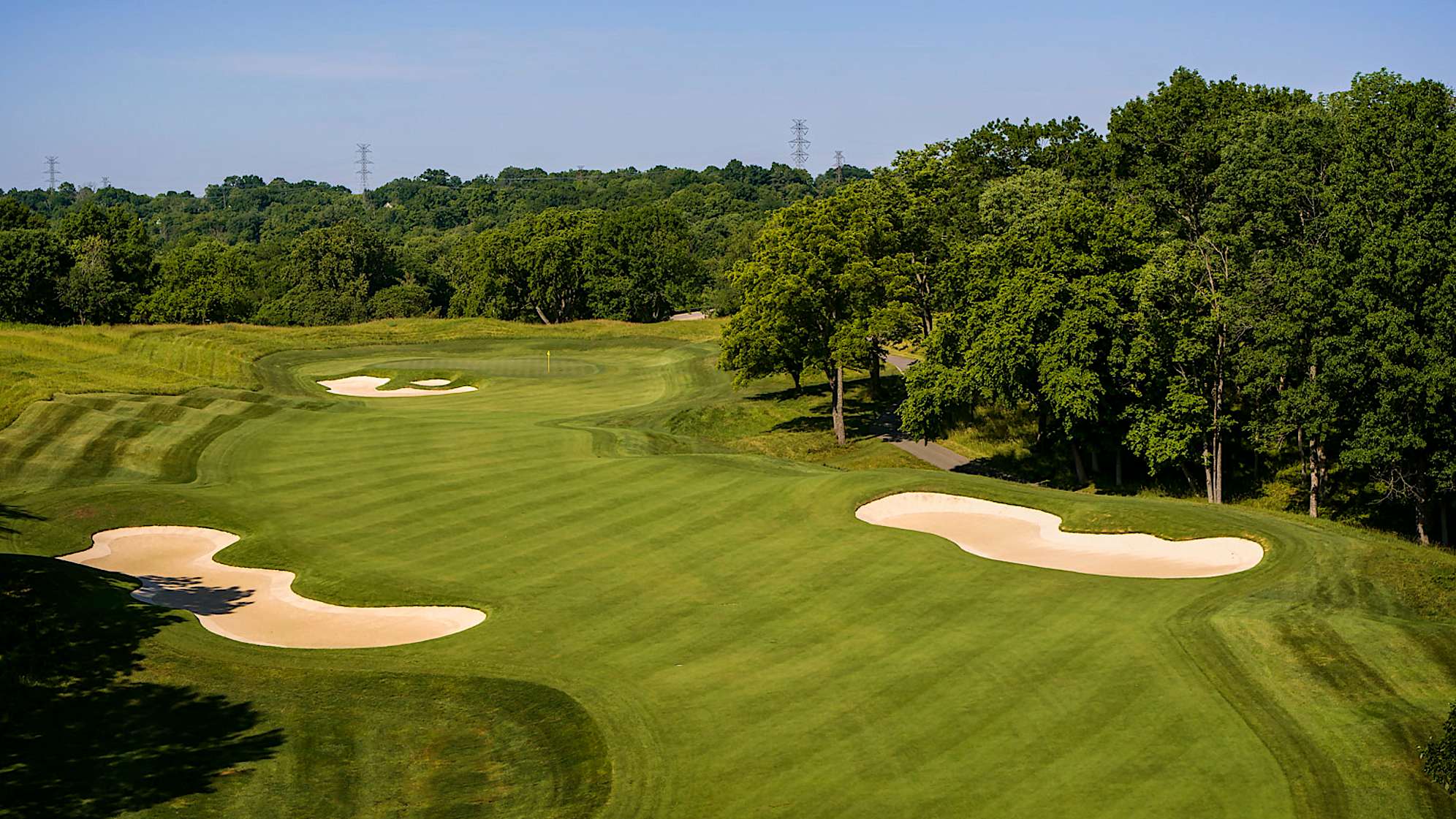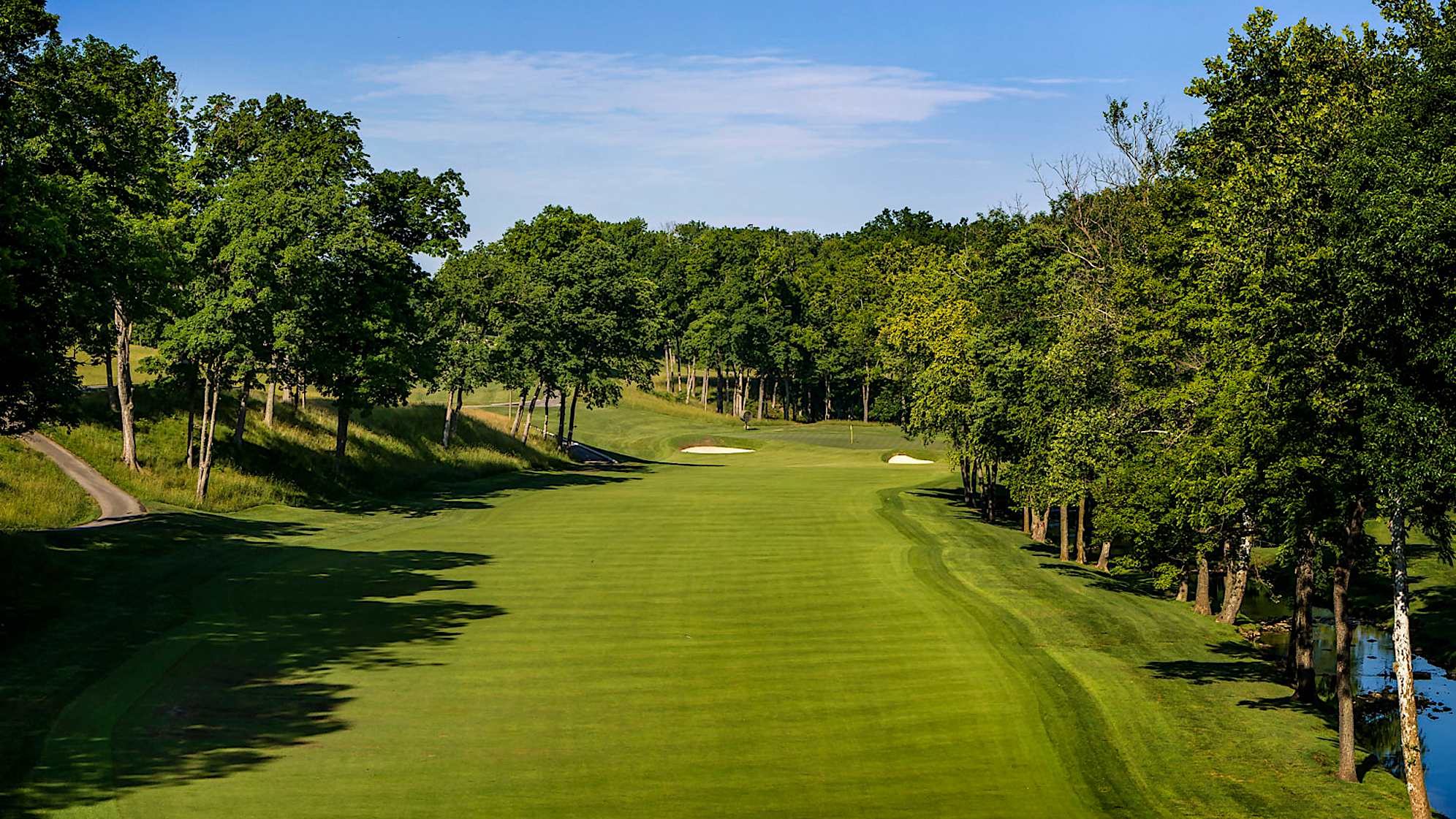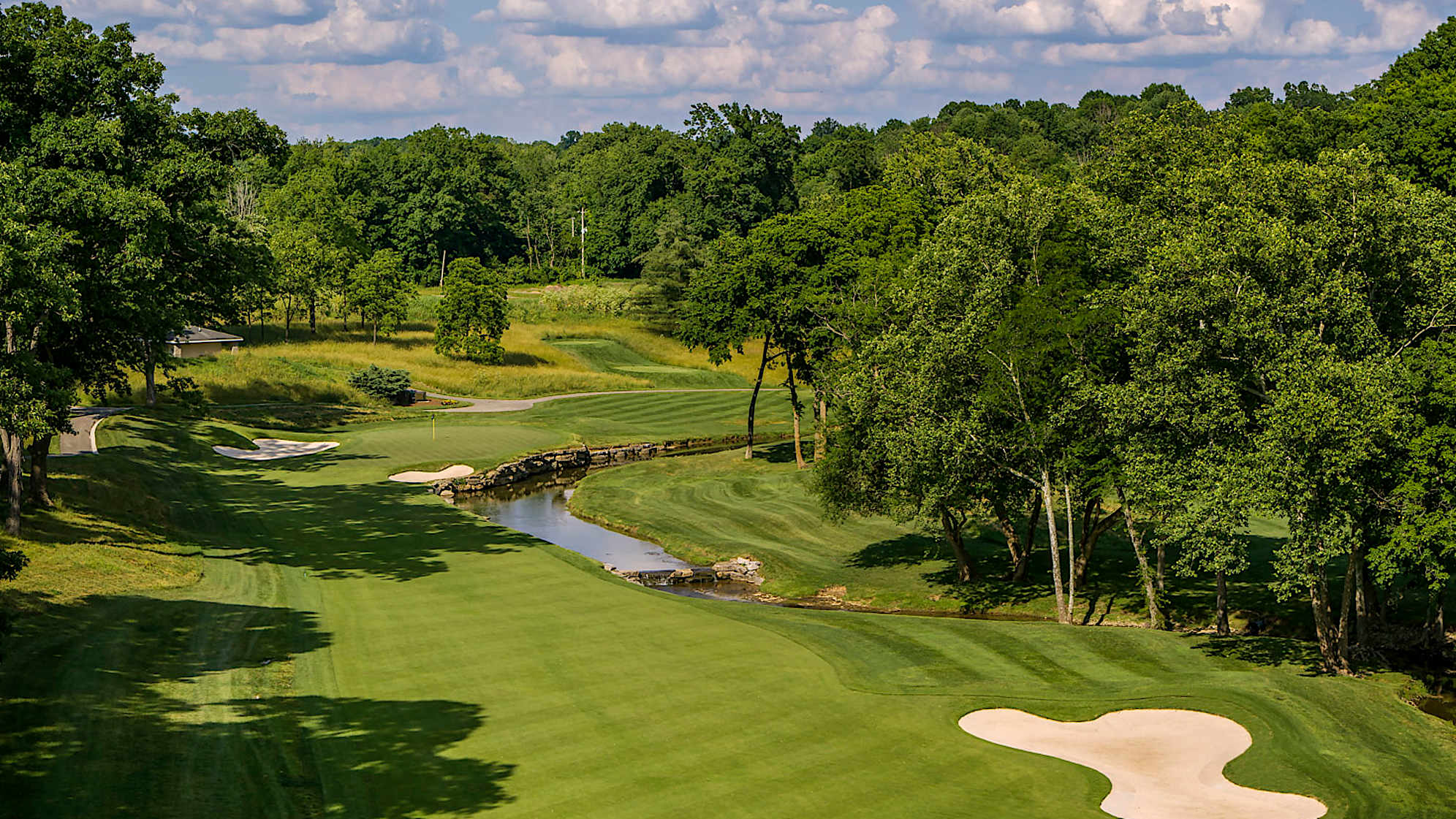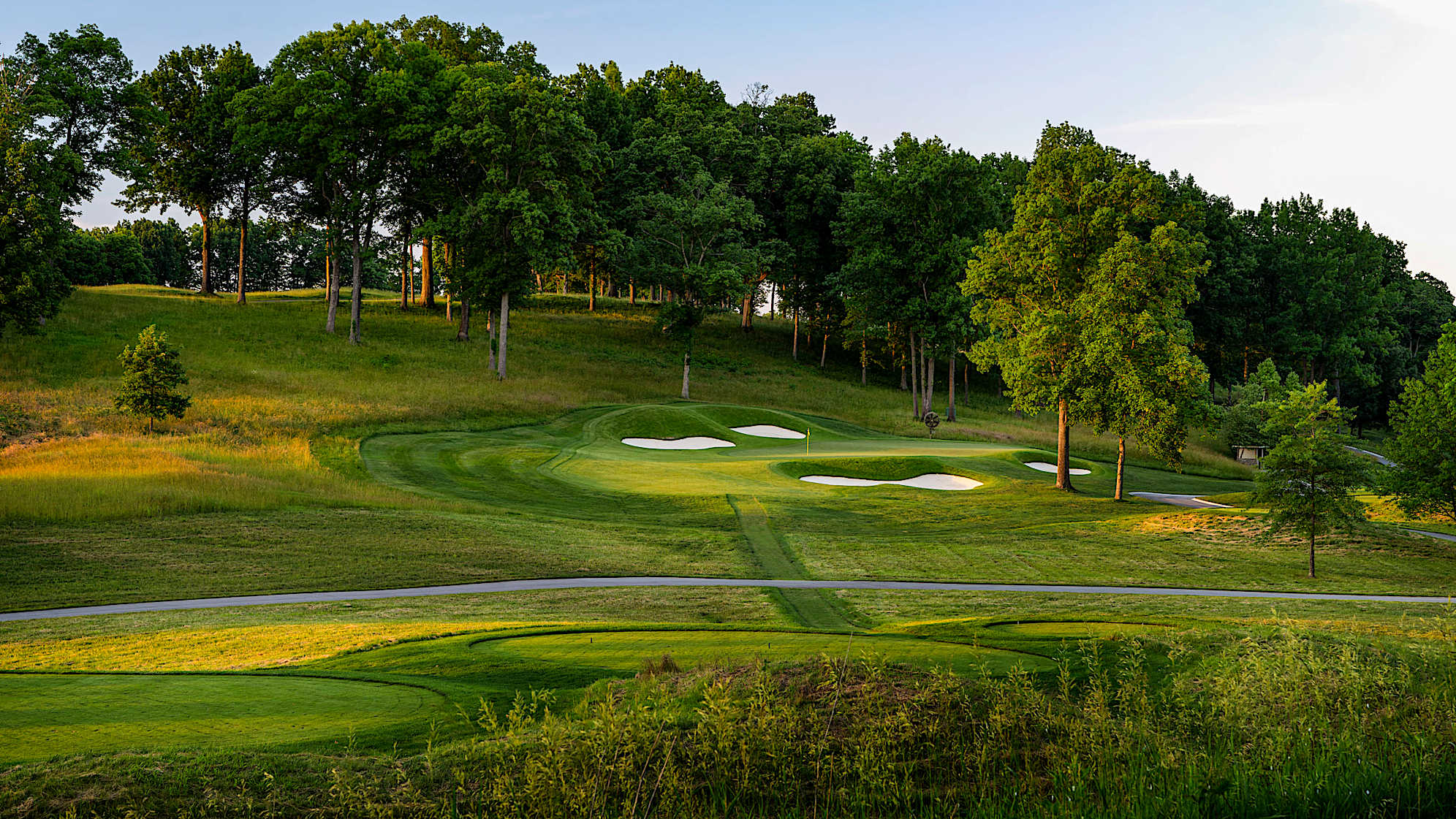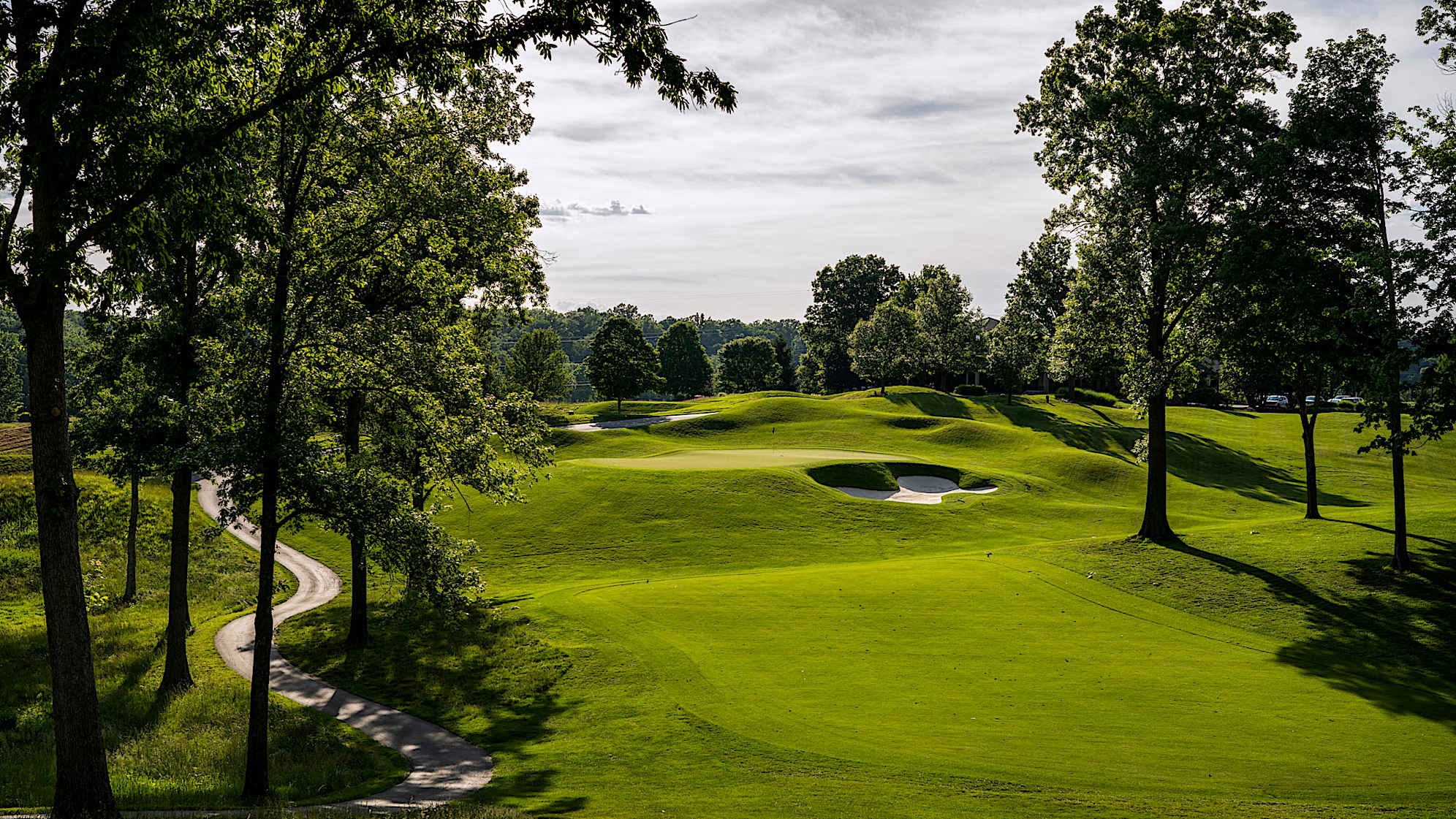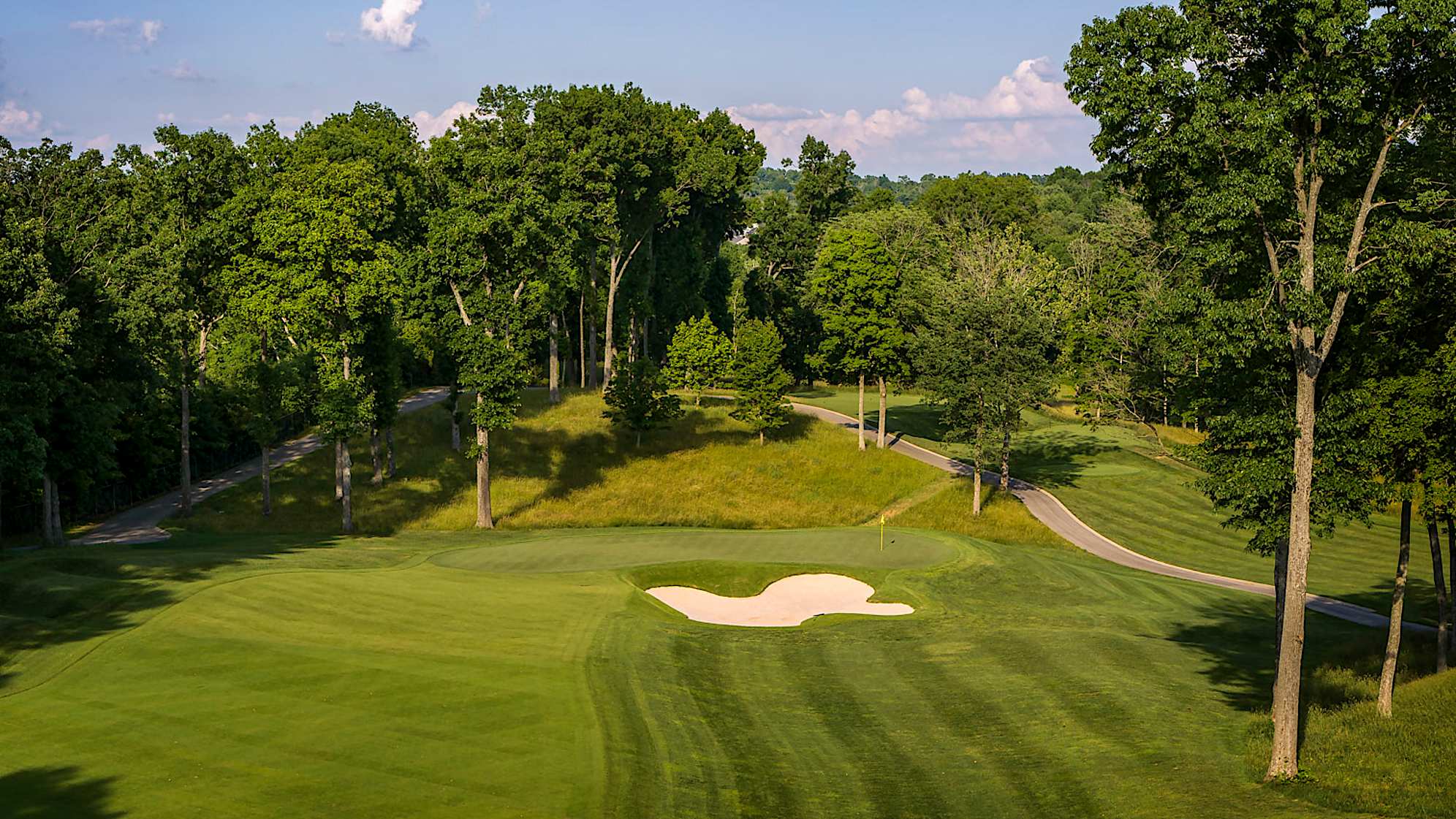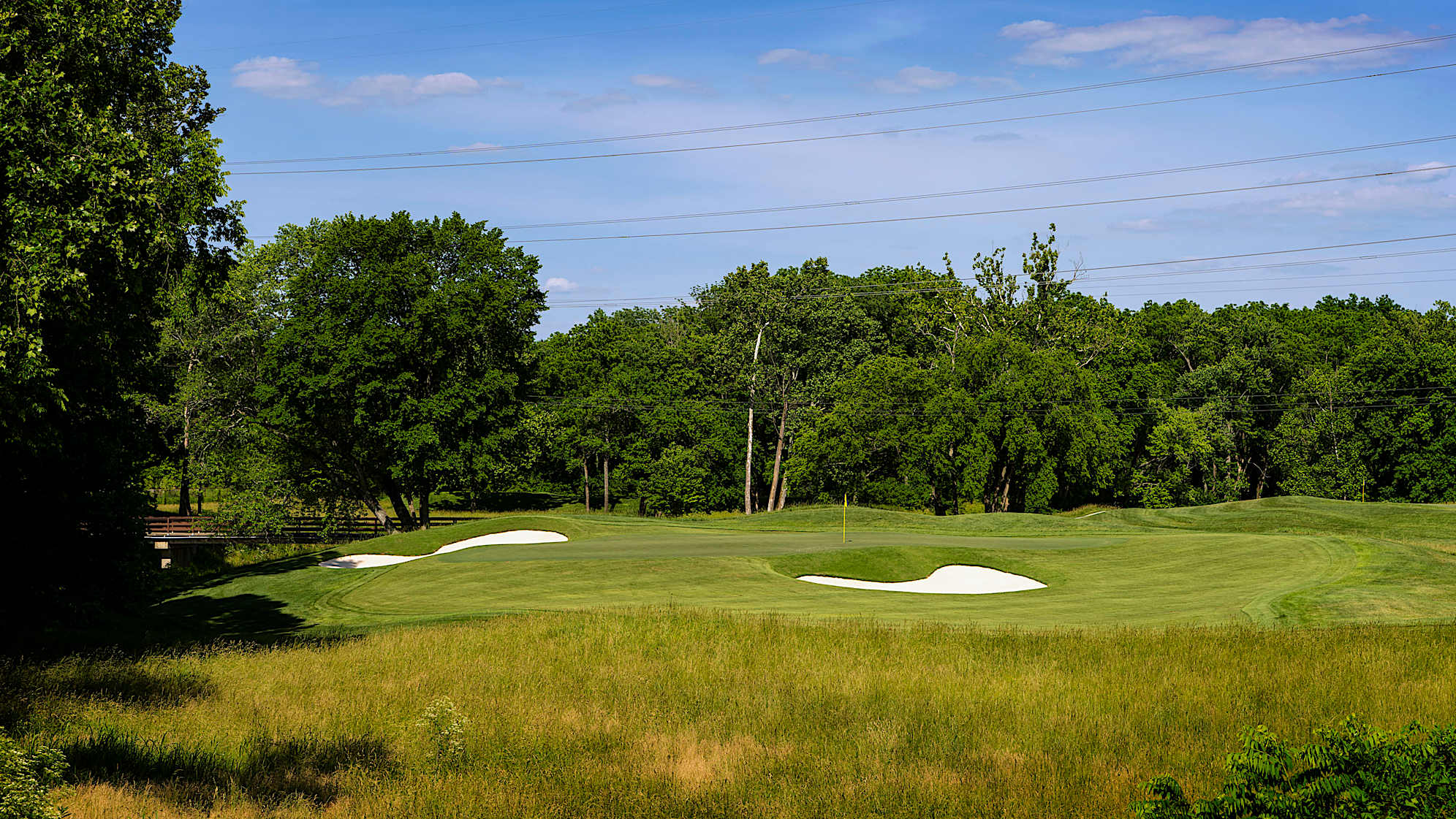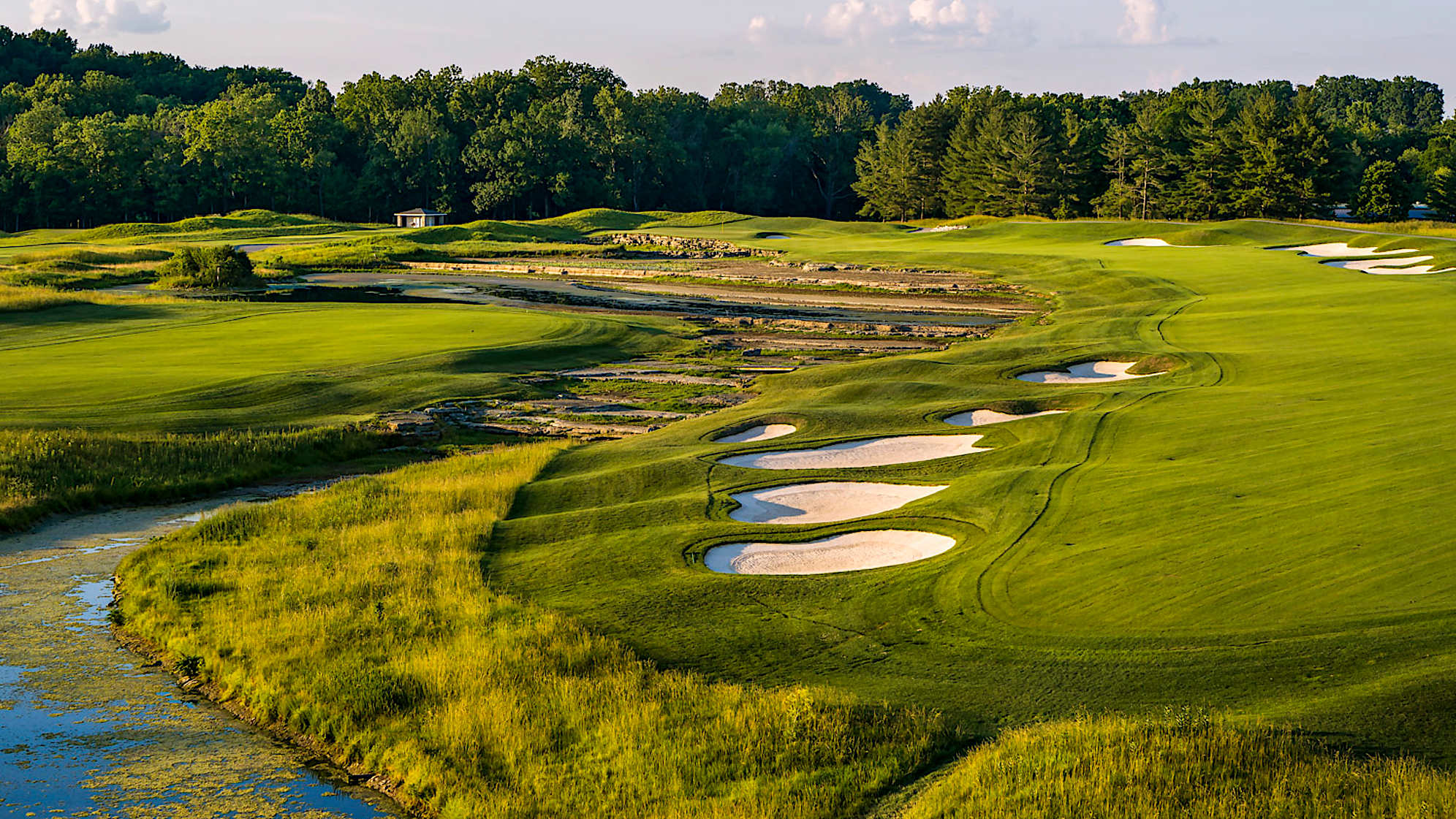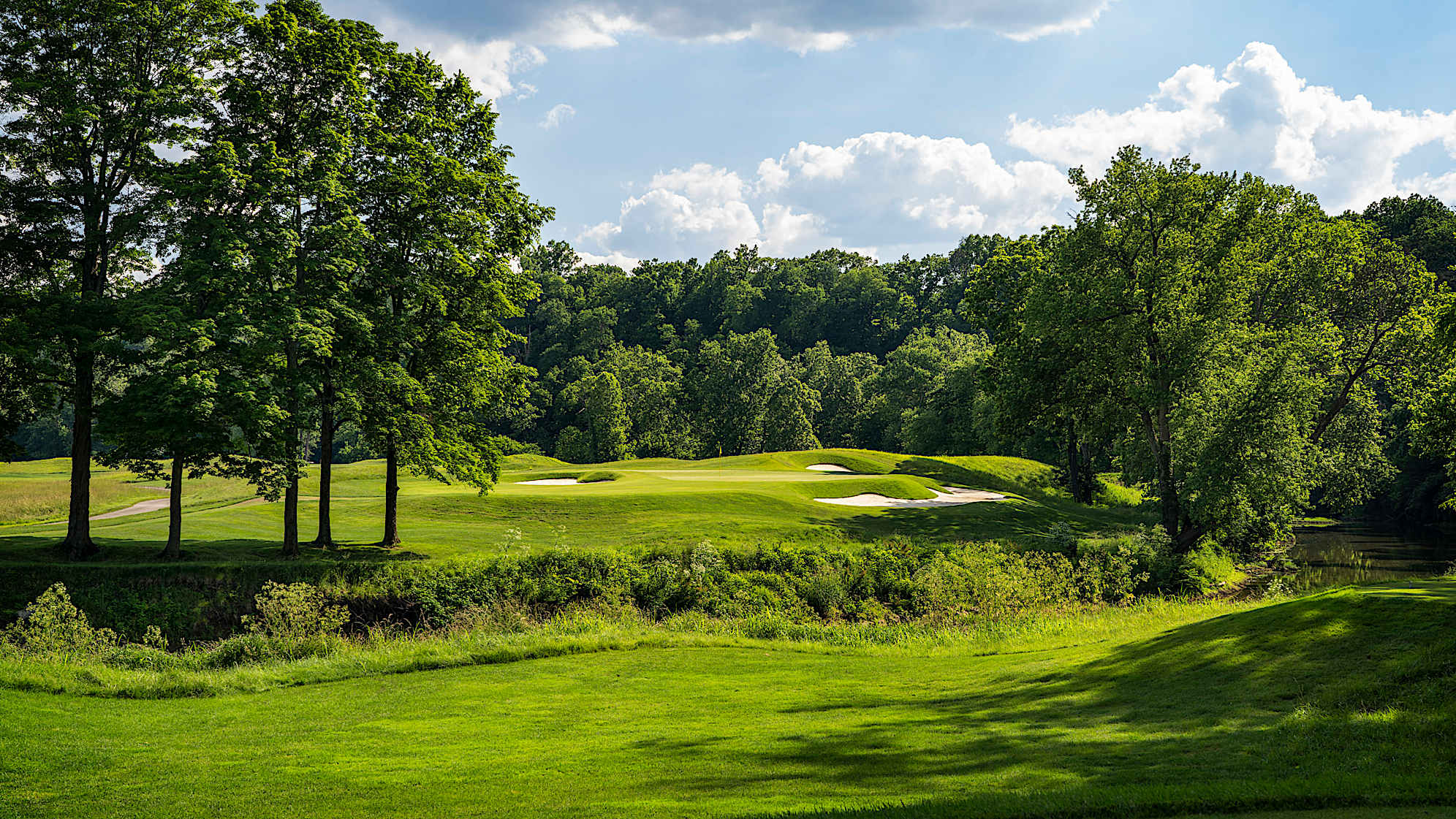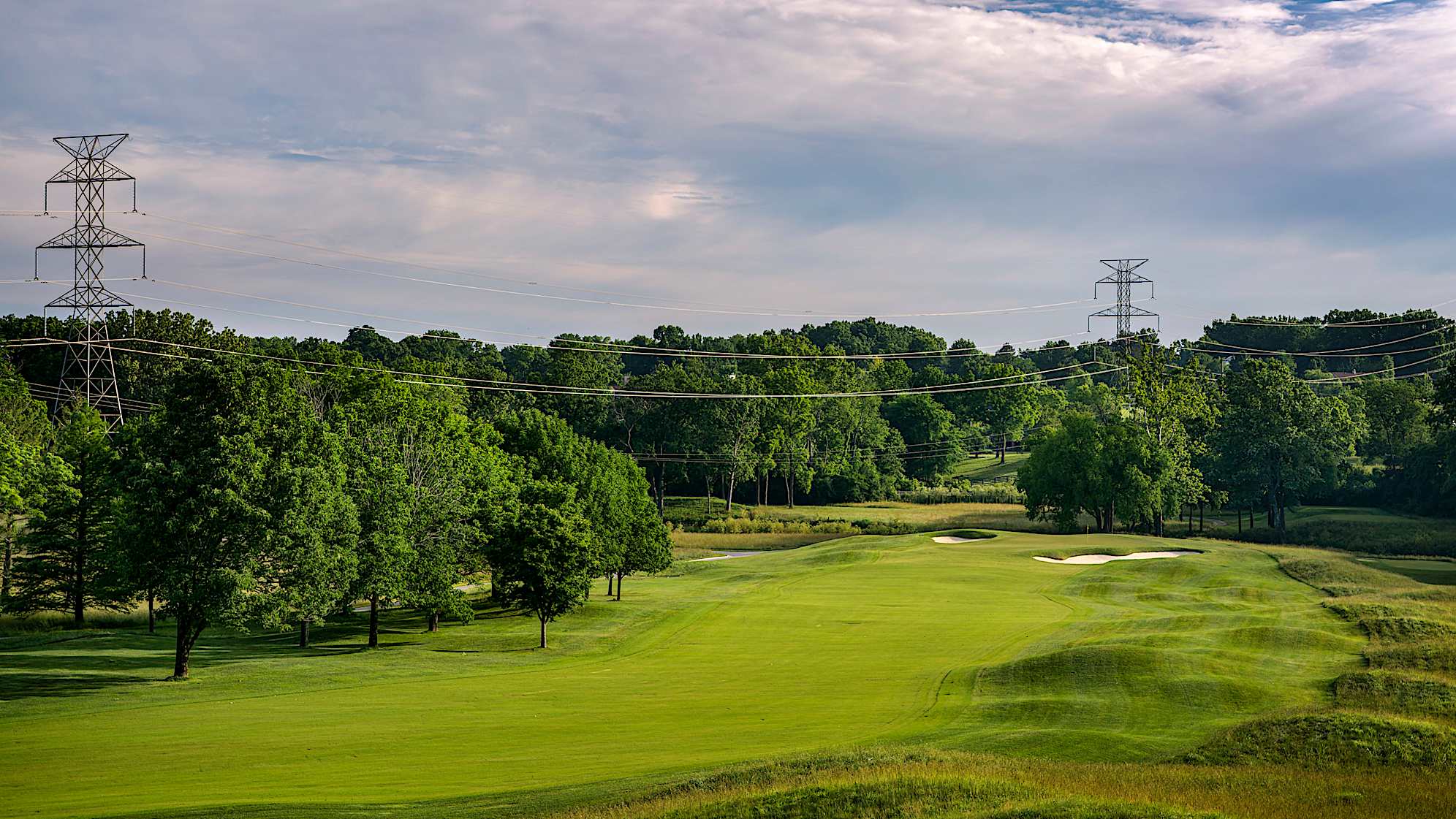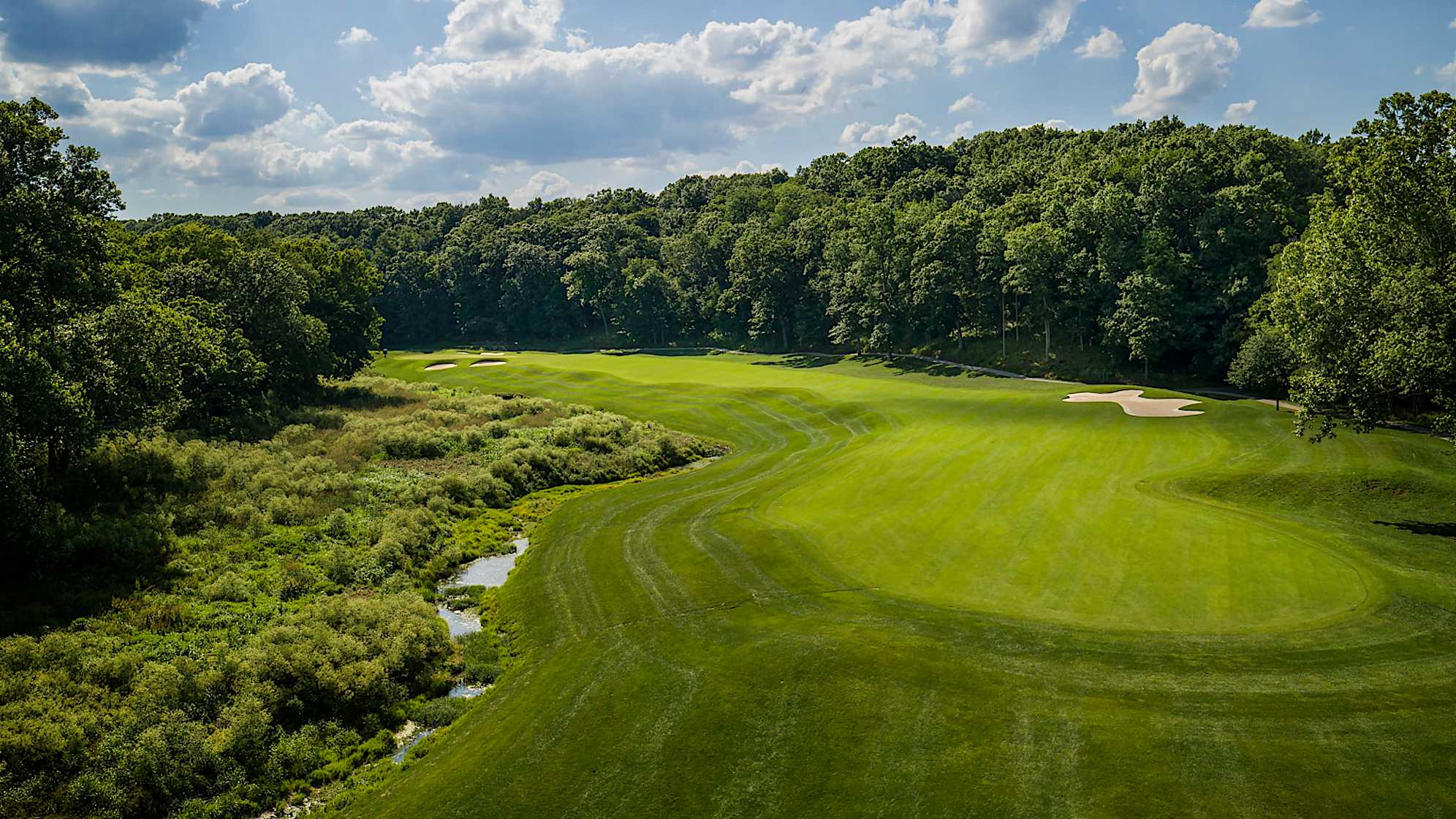Nine things to know: All about Valhalla Golf Club
9 Min Read
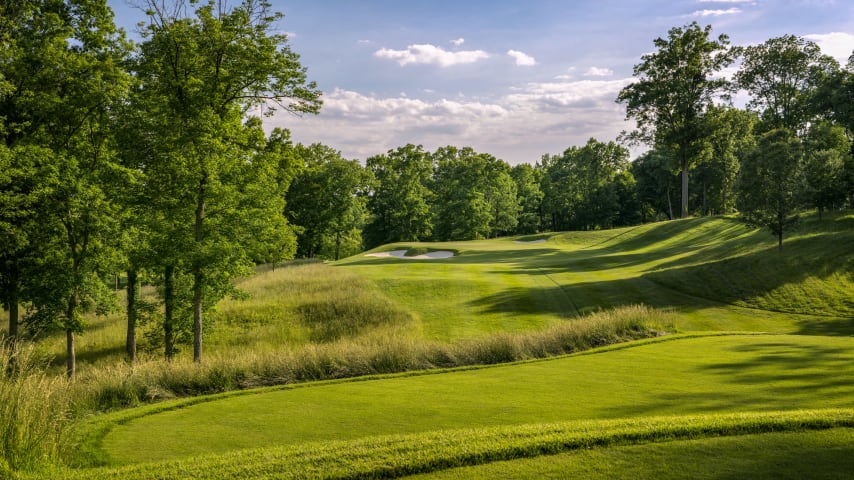
No. 11, Holler: It’s a middle- to long-iron shot into a shallow green that features a slight false front, with a large bunker in front and a smaller one behind. The green angles right to left, but shots going too far left will bound down the steep hillside. (Source: PGA of America)
Valhalla Golf Club in Louisville, Kentucky, was built specifically to host major championships, and it has stood the test of time. Now recently polished and upgraded, the course is ready to host this year’s PGA Championship.
1. WHAT’S IN A NAME?
Its name alone invokes epic tales, and it has been the site of some. Valhalla refers to the mythological Norse hall of slain warriors who rest under the watchful eye of the warrior god Odin. A bit fanciful, perhaps. But the original ownership hired Jack Nicklaus in the 1980s to design a major-championship venue, and the venue has produced memorable theatrics during three PGA Championships (1996 – Mark Brooks; 2000 - Tiger Woods; 2014 – Rory McIlroy), two Senior PGA Championships (2004 – Hale Irwin; 2011 – Tom Watson) and the 2008 Ryder Cup (USA). Perhaps another humbled god of yore can rise again this time.
The first PGA saw Kentucky’s own Kenny Perry fall in a sudden-death playoff to Mark Brooks. Perry made a mess of the first extra hole after making the questionable decision to be interviewed in the CBS broadcast booth instead of keeping warm on the range. Perry also lost a sudden-death playoff at the 2009 Masters after making bogey on the final two holes of regulation. He never did get his major championship, but he got redemption in his home state when, at the age of 48, he was a member of the U.S. Team that won the 2008 Ryder Cup at Valhalla. That team, captained by Paul Azinger, set a template that the U.S. side has been trying to replicate since.
Valhalla’s next PGA, held just four years after Brooks’ victory, was Woods’ third consecutive major win. He became the first man since Ben Hogan in 1953 to win three majors in the same year and went on to win the following year’s Masters to complete the Tiger Slam. Woods had to hole a downhill, sliding 7-footer for birdie to force a playoff with plucky underdog Bob May, then dispatched of him in a three-hole playoff. The scene of Woods chasing down his birdie putt and pointing at the hole on the first extra hole is perhaps the most famous moment at Valhalla.
McIlroy will mark something of a milestone when he returns to Valhalla this week. This was the site of his fourth – and most recent major – victory. That tournament was held in August, so we are a few months short of an exact decade, but there will no doubt be reflections on the fact that McIlroy won four majors from 2011-14 but has not won one since. He finished off his 2014 PGA Championship in the dark after storms delayed the final round. It was his second major win of the year, coming on the heels of his victory a month earlier in The Open.
2. BIG BALLPARK
This is a golf club, not a country club, and everything about it is big in scale. It’s a golf facility built for the modern game and built for hosting big events. The 485-acre property sits 20 miles east of downtown Louisville, easily accessible by highway and with plenty of local parking to accommodate the large crowds.
With 60 feet of elevation change across the entire site, Valhalla is easily walkable. There’s also plenty of room alongside the holes to provide spectators with excellent viewing and to tuck the necessary cart paths behind mounds or in the trees. The two tees of the double-sided practice area sit 350 yards apart so there’s no need to worry about netting on the practice area, either. The takeaway? There’s no shortage of space at Valhalla.
3. HAZARD-OUS MATERIAL
The corridors at Valhalla are framed by the spartan use of bunkers and the creeks that wind through the property. There are 62 bunkers on the course, and they’re almost evenly deployed between the fairways and the greens.
The fairway bunkers tend to line the sides of the landing zones, which are approximately 25 yards wide. They’re not necessarily there to define ideal lines of play or to present players with risky, but rewarding, carries. They simply constrict the landing areas and penalize those who stray from the fairway.
The greenside bunkers also help define aerial lines of play; these are perched up putting surfaces that are not designed for ground-game approaches. In this sense, the course is distinctly modern in its encouragement of aerial power.
Additional strategy is provided by two meandering streams: Floyd’s Fork on the front nine and Brush Run Creek on the back nine. Together, they influence play on seven holes should players come up short with their approaches or wander too far afield with their tee shots.
4. LONG GAME
Valhalla has been lengthened by 151 yards for this year’s PGA Championship, a 2% increase over its yardage in 2014. It will now top out at 7,609 yards and have a par of 71. Over that same decade, the average drive on the PGA TOUR has increased by 2.8%. That means the effective playing distance is marginally less than it was a decade ago, especially when considering the added length that iron shots travel. Valhalla’s added length is part of ongoing renovation by the Nicklaus design team. Recent changes were concentrated on four holes: the par-4 first and 12th holes, the par-3 14th and par-5 closing hole.
The first hole will now play approximately 50 yards longer, while 20 yards have been added to No. 12. The 14th hole can now be played as a 250-yard par-3.
5. THREE KEY HOLES
These are three holes to keep an eye on this week:
No. 4: The 372-yard par 4 normally plays as a lay-up off the tee to a tightly-bunkered fairway and then a wedge to a well-guarded green. But the PGA’s Chief Championship Officer, Kerry Haigh, has indicated that the tees will “probably” be moved up at some point, in which case many players will tempt what amounts to a 305-yard carry to the green. Making the hole drivable brings Floyd’s Fork into play left of the putting surface.
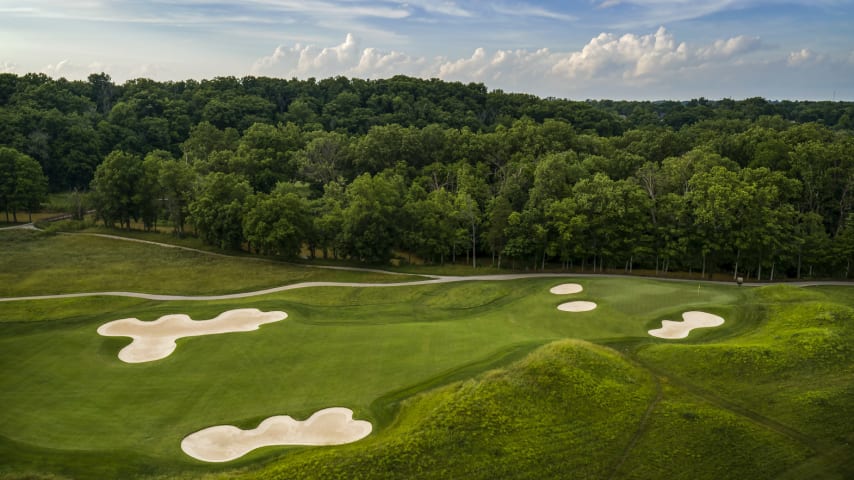
Mine That Bird: The aggressive line on this short-ish par 4 is down the left side, carrying the large bunker at the inside of the dogleg-left’s elbow. When the tee is moved forward most players can drive the green, but this brings Floyd’s Fork into play to the left side of the green and the putting surface features significant movement and contours. Golfers who choose to lay back and approach with a wedge will need precise distance control to get near the hole wherever it’s positioned. (Source: PGA of America)
No. 6: This 495-yard par 4 will likely be the toughest hole all week. Players have to back off on a driver because the fairway ends at 295 yards, bisected by Floyd’s Fork. It’s a 340-yard carry past trees and creek to reach the other side. Modesty off the tee leaves most players with 200 yards remaining to a perched green that falls off steeply on the left. Miss the fairway off the tee and par becomes very elusive.

Long Shot: The name “Long Shot” refers not to distance but one’s chance of making a par on this difficult hole. It demands an accurate tee shot, and for some players will be something less than a driver as the aim is to get as close to Floyd’s Fork as one dares. Even after a good drive, players will still be looking at over 200 yards to a challenging green complex: A deep bunker guards the left side, a closely mown collection area lurks on the right. (Source: PGA of America)
No. 13: This 351-yard par 4 is Valhalla’s most photographed hole, and for good reason. It plays from an elevated tee to a densely-bunkered fairway. The approach is hit to a fortress of an island green that has absolutely no support around it. You either hit the 5,662-square-foot green or you are in the water. The risk-reward ratio is extremely high, so everyone rational lays up off the tee and then tries to hit the green with a wedge. The hole has recently been excavated anew to expose its supportive limestone and adjoining waterfall. It's quite the spectacle.

The Limestone Hole: Don’t let the distance deceive you: Yes, it’s the shortest two-shot hole on the course, but those two shots have to be good. A cluster of six bunkers sits just to the left of the fairway landing zone, while the green is a true island, surrounded by water and built up nearly 20 feet on large limestone boulders. (Source: PGA of America)
6. THAT 18TH
Fitting for a course in Kentucky, the 18th hole is nicknamed “Photo Finish,” and it has provided plenty of those. Two of the three PGAs held at Valhalla have been decided in a playoff, while the other was a one-shot victory.
For this year’s PGA, the par 5 has been lengthened by 28 yards to 570. It's still within reach of most of the field, but players will need to hit the fairway to get home in two.
The oversized green is 6,534 square feet. It wraps around a mammoth “lion’s mouth” bunker that is in front of the green and divides it into three sections. The green serves as center stage, surrounded by hills that create a huge amphitheater for spectators.

Photo Finish: This epic finishing hole bends gracefully to the right, with a large bunker to the left of the landing zone and a beautiful water feature on the right. Most players can get home in two, but will have to contend with a big bunker in front and a smaller pot bunker left. The vast, horseshoe-shaped green has distinct putting areas left, center, and right, so simply getting on the surface is no guarantee of a good score. (Source: PGA of America)
Perry bogeyed the hole in 1996, then watched Brooks make a 4-footer for birdie to force a playoff. Brooks birdied it again to win on the first extra hole.
Four years later, Woods had to hole a 7-foot birdie on No. 18 to force a three-hole playoff with May. And in 2014, the PGA had one of its most memorable finishes as McIlroy asserted himself on the 18th tee, finishing in the dark to avoid having to return the next day to complete his one-stroke win.
7. NEW GRASS
Louisville occupies what turfgrass folks call the “transition zone.” That is the mid-central region of the United States, which is in between a more Northern climate that favors bentgrass and a Southern climate suited for Bermudagrass. The mid-season heat and humidity that Valhalla endures is not ideal for cool-season grasses, and that meant that the club’s original bentgrass fairways and tees were prone to wilting and required extra care.
In 2021, the club switched 30 acres of fairway and teeing grounds to Zeon Zoysia, a fine-bladed turfgrass that thrives in the local conditions and requires less water, chemicals and labor. That leads to annual savings of $250,000 in maintenance.
From a competition standpoint, the Zoysia will play firmer, faster and effectively speed up the ground game, placing more of a premium on accurate ballstriking. That shrinks the playing surface because the ball will roll more after landing. In other words, it’s a more sustainable playing surface that also requires more precise play. It’s a win-win.
8. NEW GREENS
Valhalla’s greens, which were rebuilt in 2011, are on the small side for championship golf. They average approximately 5,000 square feet, which makes them the third-smallest thus far in the PGA TOUR season. Only those at Pebble Beach (3,500 square feet) and Harbour Town (3,700) have been smaller. This also is just the third time in 2024 that the TOUR pros will face bentgrass putting surfaces, following those at Augusta National and TPC Craig Ranch recently for THE CJ CUP Byron Nelson.
Valhalla’s greens are visible from the approach area, even if not every pin placement can be seen. The course generally presents itself very well visually, a design trait of Nicklaus. With putting surfaces mowed to 1/10th of an inch, they will likely support speeds of 12-12.5 on the Stimpmeter. The breaks tend to be subtle, not swooping, and particular attention must be paid to putts inside 5-6 feet given the presence of modest contours at the cup.
9. SUPER STUFF
Valhalla’s superintendent, John Bollard, is a 25-year veteran of the turfgrass industry. He has spent the past five years at Valhalla, where he oversaw the installation of the Zeon Zoysia fairways and tees. He’s also been prepping for his first professional major through close observation of the set-ups at Southern Hills for the 2022 PGA and last year at Oak Hill. It helps having a brand-new shop and storage area, plus the support of three assistants, a total of 40 employees, and – for championship week – another 125 volunteers.
He'll have Valhalla ready for another memorable finish.
Valhalla Golf Club
2024 PGA Championship
Card of the course:
| Hole | Par | Yardage |
| 1 | 4 | 484 |
| 2 | 4 | 500 |
| 3 | 3 | 208 |
| 4 | 4 | 372 |
| 5 | 4 | 463 |
| 6 | 4 | 495 |
| 7 | 5 | 597 |
| 8 | 3 | 190 |
| 9 | 4 | 415 |
| 35 | 3,724 | |
| 10 | 5 | 590 |
| 11 | 3 | 211 |
| 12 | 4 | 494 |
| 13 | 4 | 351 |
| 14 | 3 | 254 |
| 15 | 4 | 435 |
| 16 | 4 | 508 |
| 17 | 4 | 472 |
| 18 | 5 | 570 |
| 36 | 3,885 | |
| 71 | 7,609 |
Bradley S. Klein is a veteran golf writer and author of 10 books on course design. A former PGA TOUR caddie, he was architecture editor of Golfweek for over two decades and is now a freelance journalist and course design consultant. Follow Bradley S. Klein on Twitter.


